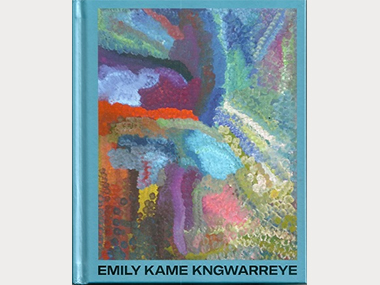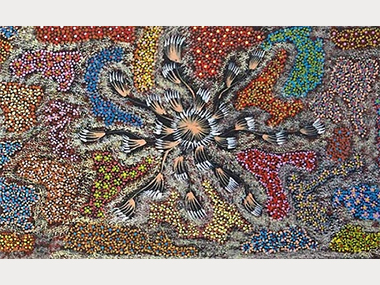EMILY v DOROTHY

The 2001 'Big Telstra' winner by Dorothy Napangardi 'Salt on Mina Mina', 2.5 metres wide, and now in MAGNT's Telstra Collection
Posted by Jeremy Eccles | 30.07.20
Dates:
18.09.20
: 27.10.20
What a year for the women! Major exhibitions are currently on (with serious catalogues) for Mavis Ngallametta (QAG), Nyapanyapa Yunupingu (MAGNT) and Destiny Deacon (NGV); earlier this year Emily Kngwarreye had significant sales in Sydney and New York on the back of the US recognition that she was “One of the 20 Most Influential Artists of 2019”; and now both Emily and the late Dorothy Napangardi are being hailed in new monographs.
But how different such appreciations can be. One is a commercial effort attached to selling exhibitions in Belgium, Perth and Alice Springs; but it's mostly written by the dealer who had a 26-year association with the artist which was clearly about rather more than making money. The other is in a commercial series of 'Mini Monographs' whose other Australian artists are an odd mix of women – Polixeni Papapetrou, Del Kathryn Barton and Nell – with some sort of imprimatur from the Tate Modern, which bought some of her work for the first time this year.
Sadly, despite a brief but challenging essay from the prominent Irish novelist Colm Toibin – who admits he sees the work only “with an Irish eye” - the Emily Kame Kngwarreye booklet from Thames & Hudson is a dud. From its cover on, there are 79 artworks by the woman that her first and foremost dealer, Christopher Hodges hails as “now Australia's most important international artist”, but, in my possibly blinkered eyes, only four are amongst her greater works. And eleven could be categorised as disappointing!
How on earth did they get selected, given Hodges's involvement – maybe only as an even briefer essayist than Toibin? Editor and “arts leader” Natalie King – curator of two Venice Biennale exhibitions – doesn't say. I hope they do not, as the book suggests, “define (Emily's) career”. And they're presented in such random order that there appears to be no attempt at either chronology or to reveal aspects of Toibin's interesting essay. For instance, scattered throughout are eight works from the contentious period that the most experienced Kngwarreye curator, Margo Neale defined as her “high-colorist” phase – which I admit I've never appreciated. But none are from the selection that Neale made for exhibitions in Brisbane, Japan and Canberra. There are none either from her earliest breakthrough period on canvas when her sacred yam roots (Kame) began to disappear beneath her miraculous dotting. A surprising number from this “career defining” collection are works on paper. And none come from her last flowering in what the Japanese recognised as her Zen mode.
Despite which, Colm Toibin makes literary play – as you might expect – on writer Edward Said's recognition of many artists' “late style – as a time when all has been said and a new abandon emerges”. He cites Yeats and Beethoven. I was reminded of Sir Kenneth Clark's 2006 essay 'On Aging' that Vanessa Merlino noted in D'Lan Davidson's New York catalogue earlier this year, in which he wondered about “the increased vitality of an aged hand (which) is hard to explain. Does it mean that a long assimilation of life has so filled the painter with a sense of natural energy that it communicated itself involuntarily through (her) touch? There is nothing more mysterious than the power of an aged artist to give life to a blot or a scribble”!
Toibin's comparable take on late Emily in 1996 is “the buzz and tumult of an artist starting out plus the sombre, late knowledge that she must, since time is short, risk everything to get it right”. Characteristically, Toibin has been throughout either balanced or reluctant to commit; I was never quite sure: identifying “a sort of wildness” and “a sort of fearlessness”; “brushstrokes that are fully alive, marks glistening and fresh” balanced by “a painter of what lies underneath” which “the poet Gerard Manley Hopkins called 'inscape'”. He also used his roving Irish eye to spot a connection to Ireland's colonisation by the British – in both countries he saw them attempting to “tame the land with fences, not realising that the land lives on, while they merely fade”.
I doubt that our Emily was that political! But she certainly looked around her and captured on canvas “a landscape fully known”.
Dorothy Napangardi also knew her landscapes backwards and forwards – especially the Mina Mina saltpans of a childhood before the colonists took her unwilling family into the Warlpiri settlement of Yuendumu. And artist Kathleen Petyarre (in the MCA catalogue for Napangardi's solo show there in 2002) recognises parallels with Kngwarrey. Speaking of a 1999 Karntakurlangu Jukurrpa/Women's Dreaming work, she commented, “It reminds me of Auntie Emily's work, the way she put down her Yam/Kame Dreaming – same idea. Not same Dreaming. Not same brushstrokes (either). Dorothy painting always remind me of women dancing, really in formation, dancing for ceremony”.
And that's not the only serendipitous connection between the two women. Weirdly, the retired Melbourne dealer Hank Ebes connects them. Ebes claims to have dealt with 650 Emilys during his career and still owned 243 of them when he set up his 'Emily Museum' in suburban Melbourne in 2013. Does it still exist – the website doesn't? But he also comes into the Napangardi monograph, forcing his way on to an all-women 'Return to Mina Mina' trip in 1999 when her Aunties passed on important women's business to Dorothy. Dealer and monograph author Roslyn Premont was furious at the intrusion. But she admits that Ebes's desert flying experience assisted the party's navigation.
While Emily Kngwarreye had distinct periods of painting that seemed to change each year, Dorothy Napangardi will remain in many minds as the mistress of black backgrounded works covered in energetic lines of white dotting – the dancing that Petyarre saw. In fact, she had three periods – an early subtly coloured flowering describing bush plum and bush banana food sources; that middle black and white Mina Mina period when her vertical lines represented women's digging sticks, the tall Desert Oaks from which they might be made, as well as the dancing of slim young women; and a late return to restrained colour after her father shared his Country with her in 2006, including her own 'Bilby Dreaming' conception site.
Academic Christine Nicholls augments the history and commentary on many of the 90-odd paintings in the book with some Toibinesque insights. Being a Warlpiri speaker herself, she has a bit more context than him. Despite which she observes “a Proustian struggle (in Dorothy) to reconnect with an elusive past”. Given the gift of a studio in Alice Springs laid on by Premont's Gallery Gondwana pretty much for her personal use, I doubt that the struggle was that mighty. Though, being in Alice Springs, there were occasionally temptations to stray. Perhaps this is a price remote artists pay for their agency in choosing a private dealer over a community art centre.
Certainly the monograph's many photos of an ecstatically grinning artist and the fact that Dorothy won both the NATSIAA's Best Painting and the Big Telstra awards suggest that both sides in the deal – creator and viewers – were more than comfortable.
And Nicholls's insight that a childhood “under vast desert skies” had allowed the artist to be “not constrained by specific orientations of seeing”, which meant that the “op-art quality (of the work) was derived from continual repositioning of self-as-actor/viewer/spectator. With no single focus, the viewer has to move his/her eyes up, down and through her works in order to engage. A simulacrum of movement”. Dancing on canvas – as Petyarre observed.
More contentiously, Nicholls sees the creation of the monumental canvases necessary to “do her Country justice by a bush artist” as “ultimately a learned skill”. I wonder who did the teaching? That may have occurred in the print-making she did with white professionals like Basil Hall. For it has a completeness that's rarely achieved by even the greatest 'bush artists'. Hall identified in Dorothy the same discipline that achieved such variety in her paintings, and “her ability to imagine everything in reverse was derived from her preoccupation with space”.
One can also identify a sense of the microscopic in her work that grew from her acute eyesight developed in tracking food resources in the desert. Sadly, it was on a hunting trip in an overloaded troopy that overturned when Dorothy Napangardi's life came to an untimely end in 2013. Ros Premont's grief is palpable. And that combination of the personal and the academic makes this monograph a fine tribute to a fine artist.
Final coincidence. Just about the only place where Dorothy Napangardi's monograph is currently on sale would be at the Artspace 'de 11 lijnen' in Oudenburg, Belgium. Their show is called 'A Window on the Macrocosmos' and features Dorothy and Emily! Also the Petyarre sisters Kathleen and Gloria. Their art apparently offers a solution for the problems of our time because: “The Australian Aboriginal culture is arguably the most successful and certainly the longest surviving civilisation in human history. It is complex, focused on sustaining life in the most hostile of environments, and a source of profound practical, spiritual and cultural knowledge. Aboriginal art not only reflects the earliest period of this ancient culture, but is also of great artistic and anthropological merit. These are just some of the reasons for its unique and continued significance. Pointillist constellations, hypnotic concentric circles and meandering lines all conceal the sacred motifs traced by the ancestors in the sand and on human bodies”.
Japingka Gallery in Perth has a tribute show - modestly described as "a one-off never to be repeated Exhibition" - due to open on September 18th and run for 6 weeks. Lucky Perth. Gallery Gondwana in Alice has a showroom of Napangardis, open by appointment.
URL: https://gallerygondwana.com.au/
Share this:
»  del.icio.us
»
del.icio.us
»  Digg it
»
Digg it
»  reddit
»
reddit
»  Google
»
Google
»  StumbleUpon
»
StumbleUpon
»  Technorati
»
Technorati
»  Facebook
Facebook
Contact Details
Gallery: Japingka Gallery
Contact: Ian Plunkett
Email: japingka@iinet.net.au
Telephone: +61 8 9335 8265
Address: 47 High Street Fremantle Fremantle 6160 WA

The cover of the Thames & Hudson Emily monograph showing the 'colorist' work 'Untitled/Alhalkere' (1993)

Early Napangardi - her 1997 work, 'Yuparli/Bush Banana' (part), which was shown in her MCA show and is on offer at Japingka Gallery
Further Research
Artists: Destiny Deacon | Dorothy Napangardi | Emily Kame Kngwarreye | Gloria Petyarre | Kathleen Petyarre | Mavis Ngallametta | Nyapanyapa Yunupingu
News Tags: Christine Nicholls | Christopher Hodges | Colm Toibin | Gallery Gondwana | Jeremy Eccles | Mina Mina | Natalie King | Roslyn Premont | Tate Modern | Thames & Hudson
News Categories: Australia | Blog | Book | Europe | Exhibition | Feature | Industry | News
Exhibition Archive
- 27.08.20 | Goodies from Canberra
- 25.08.20 | Tarnanthi 2020
- 24.08.20 | Art Fairs Exit - and Entrance
- 12.08.20 | Fairs Fare
- 07.08.20 | “The Art of the Nation”
- 06.08.20 | The Salon, 2020
- 30.07.20 | EMILY v DOROTHY
- 15.07.20 | Repatriated Art at Auction
- 08.07.20 | Kaurna Shield Comes to Adelaide
- 02.07.20 | Yiribana
- 26.06.20 | Fashion Goes Indigenous
- 02.06.20 | RIP Malu Gurruwiwi – Custodian of the Banumbirr
- 11.05.20 | BIDYADANGA CLOSE-UP
- 07.05.20 | Boomerang Back to the Start
- 29.04.20 | Cooked???
Advertising

